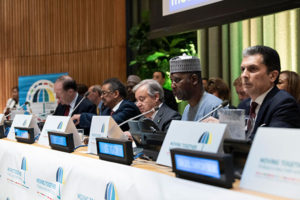
Welcome to UN Week in New York City … when savvy residents know better than to venture anywhere near the east side, avoid driving (or cabbing) below 50th Street and that the quickest way to get anywhere is by subway or on foot. Gridlock disaster doesn’t begin to describe it.
It’s a time when global leaders come together to talk about mutually important issues, like climate change (check out Greta Thunberg’s speech), trade, war and peace and world health.
A high-level meeting on universal health coverage, “Universal Health Coverage: Moving Together to Build a Healthier World,” brought together heads of state, political and health leaders, policymakers and universal health coverage champions on Monday to advocate for health for all. Leaders issued a joint declaration, calling for countries to commit to achieving universal health coverage by 2030. This includes access to essential health services, like a skilled health workforce, financial risk protection, and access to safe, quality, effective and affordable medicines and vaccines for all.
Among the most pressing health issues is population aging. It’s not just the U.S. that’s getting older — nations worldwide are experiencing a shift in demographics and seeking cost effective ways to care for, house, and support their aging populations, according to a report from the World Health Organization. The world will soon have more older people than children and more people at extreme old age than ever before, the group says. While people are living longer, not all are living in good health, or with sustained periods of social engagement and productivity.
“Population ageing is poised to become one of the most significant social transformations of the twenty-first century, with implications for nearly all sectors of society, including labour and financial markets, the demand for goods and services, such as housing, transportation and social protection, as well as family structures and intergenerational ties,” according to the report.
If you cover any aspects of global aging, or want to compare how the United States is doing against other nations, here are some quick stats and resources you can include in your stories:
- By 2030, the number of Americans aged 65 and over will nearly double.
- By 2040, more than one in three adults in Germany, Italy, and Japan will be retirees.
- By 2050, there will be nearly 100 million Chinese over age 80 — and more South Koreans may be turning 90 each year than being born, according to data from the Global Aging Institute (this nonprofit is supported by a grant from Prudential plc).
- The number of “older old” people (over 80) will be unprecedented in the developed world. According to The Levin Institute at The State University of New York many cities across the U.S. are realizing that within five years, retiree health care will cost more than employee healthcare and will consume nearly one-third of the cities’ budgets.
- When it comes to the U.S. population, a report from the Census Bureau found America’s 65-and-over population is projected to nearly double over the next three decades, from 48 million to 88 million by 2050.
- By 2050, global life expectancy at birth is projected to increase by almost eight years, climbing from 68.6 years in 2015 to 76.2 years in 2050.
- The global population of the “oldest old” — people aged 80 and older — is expected to more than triple between 2015 and 2050, growing from 126.5 million to 446.6 million. The oldest old population in some Asian and Latin American countries is predicted to quadruple by 2050.
- Among the older population worldwide, noncommunicable diseases are the main health concern. In low-income countries, many in Africa, the older population faces a considerable burden from both noncommunicable and communicable diseases.
- Risk factors — such as tobacco and alcohol use, insufficient consumption of vegetables and fruit, and low levels of physical activity — directly or indirectly contribute to the global burden of disease. Changes in risk factors have been observed, such as a decline in tobacco use in some high-income countries, with the majority of smokers worldwide now living in low- and middle-income countries.
- Japan has the world’s oldest population. Many nations are looking to them for clues on handling the health, economic and social challenges of aging, according to Bloomberg.
- Former Harvard professor William Haseltine discusses why our world Is aging in this Forbes article. Earlier this year, CNN looked at how marketers are turning global aging into a business opportunity.
The NIH’s Gateway to Global Aging Data, is a platform for population survey data. There’s a digital library of survey questions, a search engine for finding comparable questions across surveys, and identically defined variables for cross-country analysis.
The Global Aging Initiative (GAI) explores the long-term economic, social, and geopolitical implications of demographic change, and especially population aging, in the United States and around the world. The Center for Strategic & International Studies established the GAI in 1999 to raise awareness of global aging, to inform policymakers and the public about the challenges it poses, and to encourage timely and constructive reform.
 Learn more
Learn more
As we’ve seen, the senior population in your community is growing. Are you covering the health stories that accompany this local growth?
Join us for a specialty workshop next month that will provide you the data, the experts and the story ideas you can put to use right away. Visit the Journalism Workshop on Aging and Health website.








